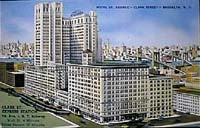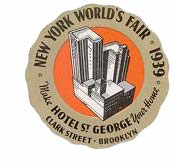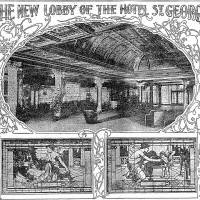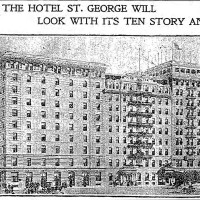A History of the St. George
The history of the St. George is tied up with that of New York City, with the changing fortunes of Brooklyn, and with world events that helped shape New York and the country. The Tower and Grill buildings that make up our co-op were once part of the Hotel St. George, one of the largest hotels in the world and, at one time, the largest in New York City.
In the pre-World-War-II era, the St. George was a popular venue for society gatherings, weddings and celebrations, and a stomping ground for such celebrities as F. Scott Fitzgerald, Johnny Weismuller, the Olympic swimmer and star of Tarzan movies, and others who ventured over the East River to dine at the hotel’s restaurants, to dance and socialize in its ballroom, and to take in the unrivaled view of Manhattan from its upper floors and roof terrace. The hotel boasted an enormous ballroom and a 120-foot natural salt water swimming pool. In its heyday, the hotel had 2,632 guest rooms, one thousand full-time employees, could accommodate nearly three thousand people for a dance, and could provide food for seven thousand guests at any one time.
Tower Construction
The Tower and Grill buildings were completed in 1929 and 1905, respectively. Many of the original exterior architectural features remain, but others have been replaced or altered over the years. For example, the current entrance to our building was a late addition, installed when the hotel was converted into an apartment building. The original main entrance, which no longer exists, was on Clark Street.
Begun in 1885 and completed between 1890 and 1929, the Hotel St. George once occupied seven buildings and encompassed the entire block bounded by Clark, Hicks, Pineapple and Henry Streets. In addition to the Tower and Grill, there were the Cross Hall and Pineapple buildings (now a separate coop complex at 60 Pineapple Street), the Clark and Studio buildings on Henry Street (currently rental housing for college students), and the original brick building on Clark Street that was destroyed by fire in August 1995. Where that building stood, a new building that provides rental housing for college students was completed a few years ago.
As a hotel, and as a venue for meetings and celebrations, the St. George thrived in the 1920s and 1930s and into and beyond World War II. During and after the war, and during the Korean war, the hotel provided lodging for troops and their families en route to or returning from military assignments. The need for this type of lodging declined after the war and declined further with the loss of army and navy stations in Brooklyn during the late 1940s and 1950s. Concomitant with this was a decline in the popularity of the hotel, particularly as a site for weddings and social functions in the 1950s and 1960s, as venues in Manhattan and the suburbs become more popular.
Between 1963 and 1968, the hotel was sold several times, often with difficulty and under threat of foreclosure, sometimes involving complex lawsuits and bankruptcy proceedings. Its occupancy rates continued to dwindle and, by 1975, only about one-third of its 2,000 rooms were occupied, some sections or whole floors were unused and in poor repair, and the hotel employed only 40 full-time staff.
Co-Op Conversion
In the late 1970s, the Tower and Grill buildings, Cross Hall and Pineapple buildings were sold to a developer whose intention was to convert them into luxury rental apartments. The conversions did indeed take place, though not without unhappy tenants, rent strikes, lawsuits and other problems. In 1982, the owner and his development group proposed to convert the Tower and Grill buildings into co-op apartments. That proposal became a reality in 1984, and formed the basis for our co-op, owned and operated by the St. George Tower and Grill Owners Corp. Today, our co-op is one of the most desirable residences in Brooklyn Heights. It is a well-run, friendly, and neighborly building, with shareholder residents who care about its upkeep and who are happy to call it home.
READ MORE
Where the Water Tanks Were, New York Times, March 25, 2010
Architect Transforms Brooklyn Heights Co-op Lobby From Grim to Glam, Brownstoner, January 20, 2016
Walkabout: Brooklyn’s Hotel St. George (7-part series), Brownstoner, March 29, 2012
Trying to Recapture the Glory Days, Up in the Old Hotel, New York Times, April 3, 2009
The Hard Life of a Brooklyn Heights Grande Dame, New York Times, December 29, 2002
Old Brooklyn Heights by Clay Lancaster, 2nd ed., Dover Publications, New York, 1979
The Neighborhoods of Brooklyn by John B. Manbeck, consulting editor, Yale University Press, New Haven, 1998






